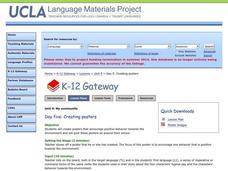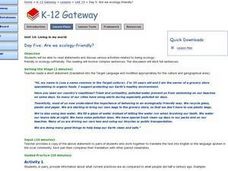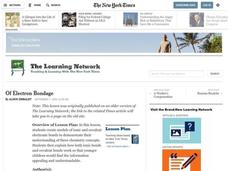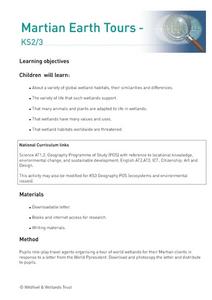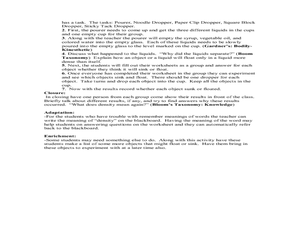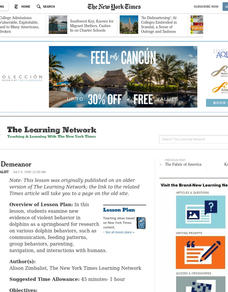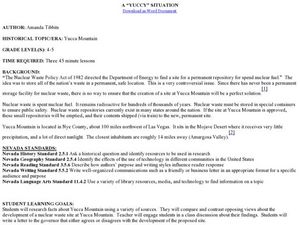Curated OER
Archaeology and Storytelling
Young scholars identify and interpret both individual families and whole cultures learn about their pasts by collecting and analyzing stories and artifacts. Then they identify that not all archaeological finds readily reveal their...
Curated OER
Levels of Classification
Students use diagrams to compare structural differences that taxonomists use to classify animals. For this classification lesson plan, students compare structures of different species from given diagrams. In one diagram they identify the...
Curated OER
Creating Posters
Students design original posters that encourage good attitudes towards the environment. In this positive environment activity, students brainstorm and create a list of positive behaviors for a good environment. Students create posters...
Curated OER
Geography and Climate
Students investigate geographical locations and their own personal experiences with the environment. In this environmental identification lesson, students participate in a match game using certain environmental and geographical terms...
Curated OER
Are We Ecology-Friendly?
Young scholars explore ecology. In this ecology lesson, students read scenarios, discuss them in groups and decide if they are eco-friendly or not. Young scholars discuss the differences in eco-friendly practices fifty years ago and now....
Curated OER
Ecology Lessons
Students examine the relationship between animal adaptations, habitats and community interactions. In this ecology instructional activity students complete a skull detective worksheet then use their knowledge to analyze a skull.
Curated OER
Of Electron Bondage
Students create models of ionic and covalent electronic bonds to demonstrate their understanding of these chemistry concepts. They explain how both ionic bonds and covalent bonds work so that younger students can understand.
Curated OER
Here Comes Winter!
Students investigate winter behaviors in animals. They describe winter and write about the characteristics of the season by drawing and labeling a winter picture. Students then conduct research on a chosen animal and create a chart. ...
Curated OER
Martian Earth Tours
Students study a variety of global wetland habitats, their similarities and differences. They examine the variety of life that such wetlands support and determine that many animals and plants are adapted to life in wetlands, that...
Curated OER
21st Century Medicine: Nerves of Steel
Young scholars model a sarcomere's action, they gain a kinesthetic and visual understanding of muscle contraction. They use this exercise stimulates the production of myosin and actin. Students use two colors of clay, make a "sandwich"...
Curated OER
Properties of Materials - Part B
Students describe the history of materials. They use the kinetic (particle) theory to explain changes of state in matter and trace the flow of heat during changes of state and chemical changes.
Curated OER
Plant Pollination
Students investigate methods of pollination for various flowers. In this plant biology lesson plan, students learn the parts of a flower and form a hypothesis about the method of pollination for the flower. They determine the validity of...
Curated OER
Get to Know a Fish
Students discover the anatomy of a fish by identifying its body parts. In this oceanography lesson, students view a live fish in their classroom and draw a poster of the fish one body part at a time while identifying it. Students...
Curated OER
Liquids: Floating and Sinking
Third graders conduct an experiment. In this floating and sinking liquids lesson, 3rd graders discuss density and investigate it using syrup, vegetable oil and colored water. Students observe the results and complete a worksheet.
Curated OER
Rain Forest Research
Second graders explore the Rain Forest. In this research lesson, 2nd graders go online to gather information about Rain Forest animals. Students print and use the information to write about the many parts of the Rain Forest. Students are...
Curated OER
Dolphin Demeanor
Young scholars examine new evidence of violent behavior in dolphins as a springboard for research on various dolphin behaviors, such as communication, feeding patterns, group behaviors, parenting, navigation, and interactions with humans.
Curated OER
Wonderful Worms
Students identify living and non-living things and explain the importance of earthworms to the soil. They name some basic facts about earthworms, recognize basic worm vocabulary words and demonstrate vermicomposting techniques.
Curated OER
The Sky Jeopardy
First graders reinforce concepts about sun, moon, day, night and sky by playing the Sky Jeopardy game. In the end, 1st graders get to nibble crackers in order to show the different phases of the moon.
Alabama Learning Exchange
Learning the Three Layers
Students examine the Earth's crust or lithosphere, mantle and core. They complete research using assigned web sites before designing a model of the Earth using items such as Play-Doh, peaches and apples.
Curated OER
What Can You Learn About Dinosaurs by Watching an Ostrich?
Learners collect a variety of drawings of dinosaurs and maps of a zoo. Students observe an animal in motion during a field trip to a zoo from reproducible worksheets. Learners study about the process by which scientists and film...
Curated OER
What is a Raptor?
Learners explore, analyze and discover the characteristics of raptors and generate a word bank for owls and raptors. They identify attributes shared by raptors and practice various key vocabulary words to master and utilize in sentence...
Curated OER
Rain Forest Adventures
Students identify and describe where tropical rain forests are located and examine the geographical correlation between rainfall and rain forest. They brainstorm what they think they know about tropical rain forests - where they're...
Curated OER
A Yuccy Situation
Students examine the concept of nuclear waste storage. In this interdisciplinary lesson, students research Yucca Mountain in order to compare and contrast opposing views regarding the nuclear waste site there. Students compose a letter...
Curated OER
An Inside Look at Apples
First graders examine and identify parts of an apple. In this biology lesson, 1st graders cut an apple in half and locate all the parts, use the apple halves as stamps, and create a bar graph displaying which apple types the students...




